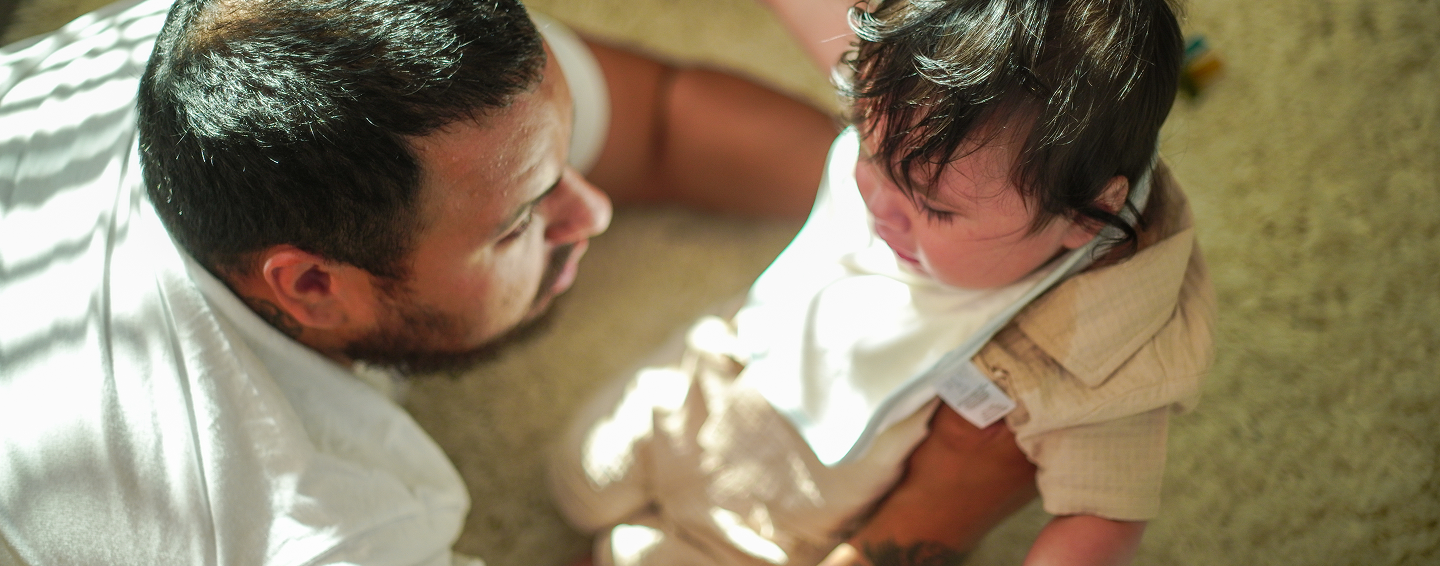Why Every Parent Needs to Know About Colic Relief Devices
A colic relief device can be a lifesaver when your baby is crying for hours and nothing seems to help. Here are the top types that actually work:
- Mechanical gas passers - Hollow tubes that instantly release trapped gas (like Frida Baby Windi)
- Heated belly bands - Warm, gentle compression wraps that soothe tummy pain
- Anti-reflux cushions - Angled supports that reduce gas buildup and acid reflux
- Combination devices - Multi-function tools with vibration, heat, and positioning
When your healthy, well-fed baby with a clean diaper won't stop crying, you're likely dealing with colic. This affects up to 20% of babies and typically peaks around 6 weeks old before improving by 3-4 months.
Colic episodes often happen in the evening and can last for hours. Your baby might clench their fists, arch their back, or pull their legs up to their chest. The good news? Modern colic relief devices offer safe, effective ways to help.
The key is understanding which type works best for your situation. Some provide instant mechanical relief, while others use warmth and compression for longer-lasting comfort.
I'm Gary Harutyunyan, and as a new father who tried every product on the market during my own baby's sleep struggles, I understand the desperation parents feel when searching for a colic relief device that actually works. My experience led me to create solutions that combine proven soothing techniques with innovative technology.
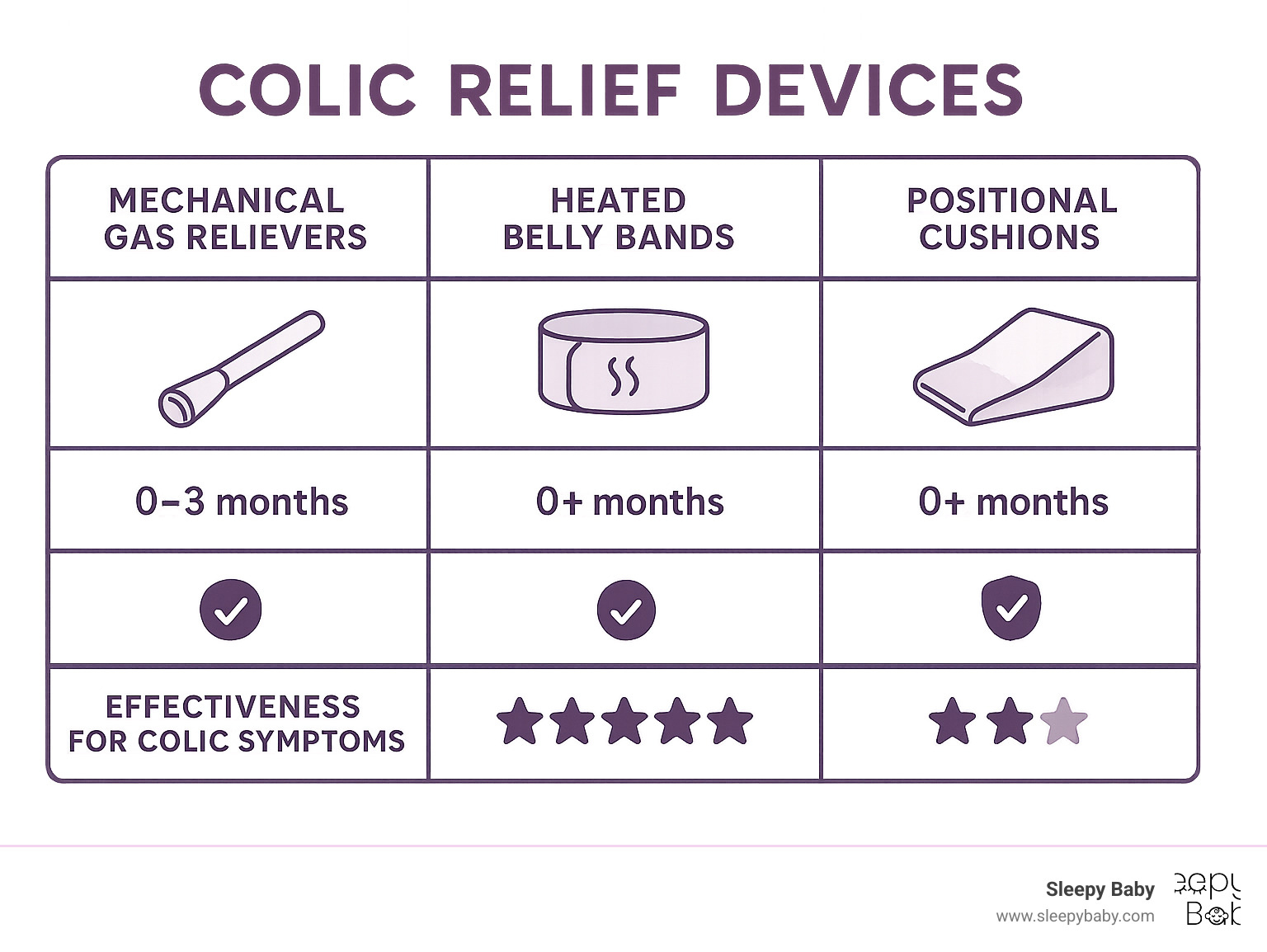
What Is Infant Colic? Symptoms, Causes, and Why Gas Hurts
If you've ever wondered whether your baby's crying is "normal" or something more, the medical definition of colic might help put things in perspective. Infant colic follows the "rule of threes" - crying for more than 3 hours a day, at least 3 days a week, for at least 1 week in an otherwise healthy baby.
According to scientific research on infant colic, these episodes typically improve after 3 to 4 months. That explains why so many parents feel like they're barely surviving those early weeks - because they literally are just trying to get through each day.
The symptoms are unmistakable once you've experienced them. Colic crying sounds completely different from hunger or tiredness. It's intense and inconsolable, often happening in the evening when you're already exhausted from the day.
You'll notice your baby's clenched fists and tensed body during these episodes. They might pull their legs up to their chest or arch their back while crying. Their face becomes red and flushed from the prolonged distress. It's heartbreaking to watch, especially when nothing you try seems to help.
But understanding what causes colic can actually be empowering. The research points to several key factors that explain why your baby is struggling - and why colic relief devices can be so effective.
Your baby's digestive system is still learning how to work. Think about it - they've never had to process food or deal with gas before birth. Many babies simply can't coordinate their muscles to pass gas naturally yet. This leads to trapped air and a tense, painful stomach that triggers more crying.
The problem gets worse because babies swallow excess air during feeding or when they're already upset. This creates even more pressure and discomfort, leading to what feels like an endless cycle of crying and gas pain.
Some babies are also more sensitive to overstimulation from their environment. The lights, sounds, and activity that seem normal to us can overwhelm their developing nervous system, making them more prone to evening fussiness.
Family diet can play a role too. For breastfed babies, certain foods in mom's diet might contribute to discomfort. Formula-fed babies might be sensitive to specific proteins or ingredients in their formula.
Understanding these root causes helps explain why the right colic relief device can provide such dramatic relief. When you address the mechanical problem of trapped gas and provide the specific type of comfort your baby needs, you can finally break that exhausting cycle of crying and pain.
Colic Relief Device Categories and How They Work
When you're dealing with a colicky baby at 2 AM, not every colic relief device will work the same way. Some babies need instant gas relief, while others respond better to gentle warmth and pressure. Understanding how different devices work helps you choose the right approach for your little one's specific needs.
Think of it like having different tools in your toolbox - each one designed for a particular job. Mechanical gas passers work like tiny emergency valves, releasing trapped air instantly. Heated belly bands act more like a warm, comforting hug that lasts for hours. Positional cushions recreate that magical chest-to-chest contact that seems to calm even the fussiest babies.
| Device Type | How It Works | Age Range | Safety Features | Best For |
|---|---|---|---|---|
| Mechanical Gas Passers | Hollow tube releases trapped gas instantly | Newborn to 3-4 months | Built-in stopper, single-use | Immediate gas relief |
| Heated Belly Bands | Gentle warmth + compression soothes digestive tract | 0-9 months (size-specific) | Anti-burn technology, organic cotton | Ongoing comfort, multiple episodes |
| Positional Cushions | Angled support reduces reflux, mimics chest contact | Premature to 6 months/21 lbs | 5-point harness, supervised use only | Reflux, needs chest contact to settle |
The beauty of understanding these categories is that you can match the device to what your baby actually needs. A baby with obvious gas pain might need the quick relief of a mechanical device, while a baby who has multiple episodes throughout the day might benefit more from a wearable solution.
Many parents find success combining different approaches based on their baby's symptoms and the time of day. What works during a daytime fussy period might be different from what helps during those challenging evening hours.
Mechanical Colic Relief Device: Rectal Gas Passers
These colic relief devices might seem intimidating at first, but they're actually based on a technique that pediatric gastroenterologists have used safely for decades. The concept is brilliantly simple - when a baby's immature digestive system can't release gas naturally, these devices provide a gentle, temporary pathway.
How they work is quite straightforward. The hollow, rounded tube is designed to bypass the sphincter muscle that often traps gas in babies. When inserted correctly past the muscle, you'll typically hear a whistle-like sound as the trapped air escapes. The relief is often immediate and dramatic - many parents describe their baby's entire body relaxing within seconds.
The benefits are hard to ignore - you get instant relief without waiting for gas drops to take effect, and there's no medication involved. These devices work when other methods have failed, and the single-use design ensures perfect hygiene every time.
Safety is built into the design with features like built-in stoppers that prevent over-insertion. The materials are BPA and latex-free, and the disposable nature prevents any risk of contamination. Most pediatricians recommend using them no more than three times per day.
The best time to reach for one is when you can see your baby's belly is tense and they're pulling their legs up to their chest. These are clear signs of gas pain, and mechanical relief often works when nothing else will.
Wearable Colic Relief Device: Heated Belly Bands
Wearable colic relief devices take a more nurturing approach to digestive discomfort. Instead of providing instant mechanical relief, these devices work by recreating the warmth and security that babies crave during their most uncomfortable moments.
The magic happens through three key elements working together. Gentle heat warms the abdomen to relax tense muscles and improve circulation - similar to how a warm compress helps adult stomach pain. Light compression provides that swaddled security feeling without restricting movement. Some devices even include natural aromatherapy elements like lavender for additional calming effects.
These devices shine in their practicality. You can put one on your baby and continue with other soothing activities like rocking or walking. They're reusable and washable, making them economical for families dealing with ongoing colic issues. The hands-free design means you're not tied to holding your baby in one specific position.
Safety features are carefully engineered with organic cotton construction to prevent skin irritation and anti-burn technology to prevent overheating. The adjustable sizing ensures a proper fit as your baby grows, and machine washable components make maintenance simple.
They work best for babies who have multiple colic episodes throughout the day or who seem to benefit from consistent gentle pressure on their tummy. If your baby calms down when you place your warm hand on their belly, a heated band might be perfect.
Positional Colic Relief Device: Anti-Reflux Cushions
Positional colic relief devices address a specific but common cause of infant distress - acid reflux and the overwhelming need for upright positioning. Many colicky babies only settle when held upright against a caregiver's chest, which can be exhausting for parents.
These cushions work by recreating that chest-to-chest experience while providing additional therapeutic benefits. Angled support keeps your baby's head lifted to prevent acid reflux from causing discomfort. Gentle vibrations mimic the natural movement of a parent's breathing. Recorded heartbeat sounds recreate the familiar womb environment that all babies find comforting.
The benefits extend beyond colic relief. These devices provide essential supervised tummy time, which helps prevent flat head syndrome while supporting proper spinal development. They give parents precious hands-free time while still providing the upright positioning their baby craves.
Safety is absolutely critical with positional devices. They require constant supervision and should never be used for unsupervised sleep. Always transfer your baby to a flat surface following safe sleep guidelines when they're ready to sleep. These devices are designed for awake, supervised comfort time only.
They're ideal for specific situations - babies who only settle when held upright, those with diagnosed reflux issues, or babies who seem to need that chest-to-chest contact to feel secure. If you find yourself spending hours each day holding your baby upright, a positional cushion might provide the relief you both need.
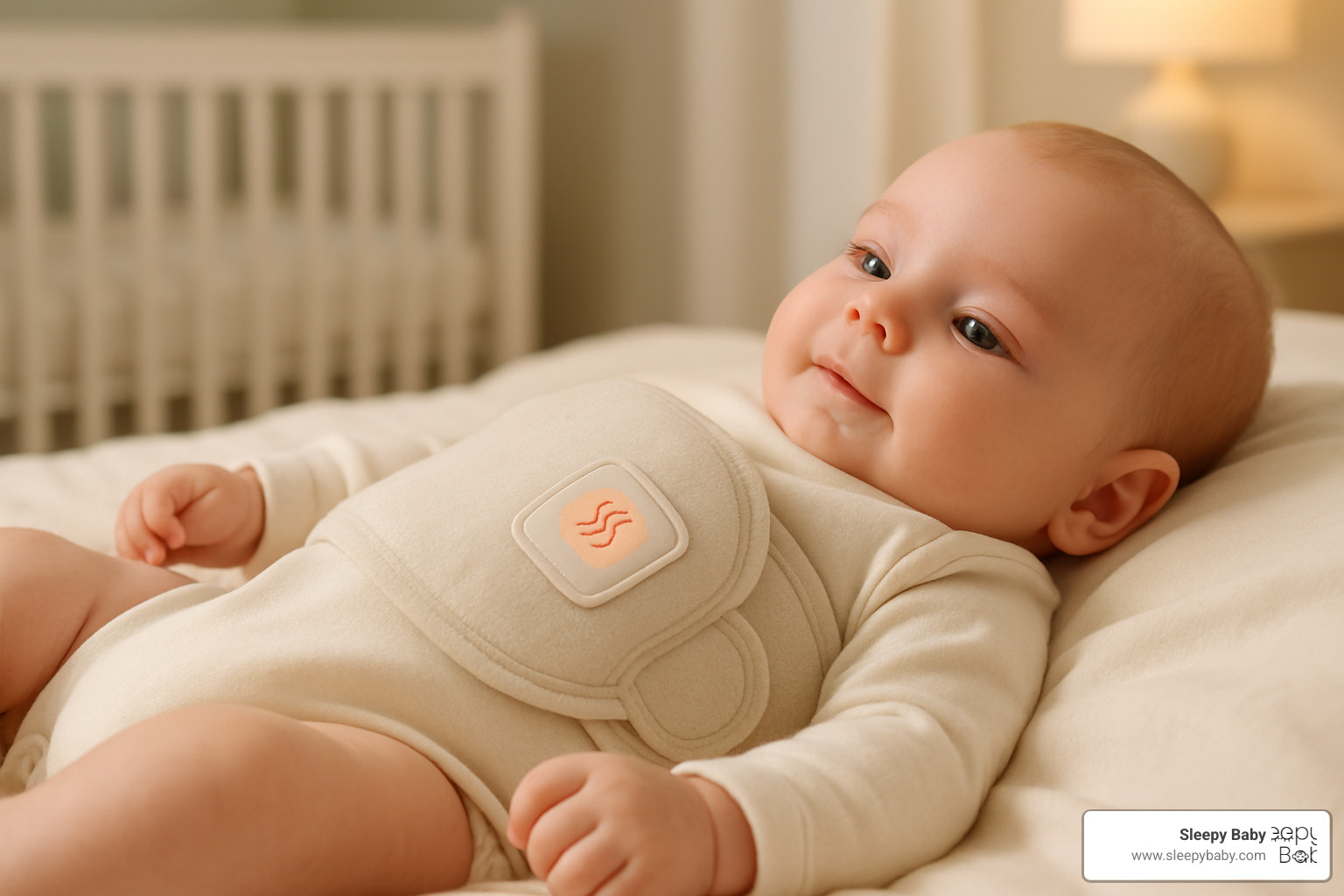
Using Colic Relief Devices Correctly and Safely
Proper use of any colic relief device is crucial for both effectiveness and safety. Here's our step-by-step guide for each type:
For Mechanical Gas Passers:
- Prepare the Area: Have a diaper or towel ready - gas release can be messy
- Lubricate: Use a safe, food-grade lubricant like coconut oil on the tip
- Position Baby: Lift baby's legs gently, similar to diaper changing position
- Insert Carefully: Gently insert only until you reach the built-in stopper
- Listen: You should hear gas passing through the tube
- Remove and Discard: Each tube is single-use only for hygiene
- Clean Baby: Wipe the area clean and put on a fresh diaper
Critical Safety Rules:
- Never force insertion
- Stop immediately if baby seems uncomfortable
- Use maximum 3 times in 24 hours
- Never insert beyond the stopper
- Discard after single use
For Heated Belly Bands:
- Heat Preparation: Warm the thermal element according to instructions (usually 15 seconds in microwave)
- Test Temperature: Always test on your own skin first
- Position Band: Place the warm element directly over baby's belly button area
- Secure Safely: Adjust straps so they're snug but not tight
- Monitor Continuously: Check baby's skin for any redness or irritation
- Remove for Sleep: Never leave on during unsupervised sleep
Safety Guidelines:
- Always supervise when in use
- Check skin regularly for overheating
- Remove if baby shows any discomfort
- Follow age and weight guidelines
- Wash according to manufacturer instructions
For Positional Cushions:
- Setup: Place cushion on a stable, non-slip surface
- Secure Baby: Use all safety harness points properly
- Turn On Features: Activate vibration and heartbeat sounds before placing baby
- Position Correctly: Ensure baby's head, hands, feet, and body all make contact
- Stay Present: Never leave baby unattended on the cushion
- Transfer for Sleep: Move baby to flat crib surface for any unsupervised time
Essential Safety Reminders:
- Constant supervision required
- Follow weight and age limits strictly
- Regular safety harness checks
- Clean according to instructions (usually machine wash covers at 30°C)
The key to success with any colic relief device is consistency and patience. It may take a few tries to find the right technique or timing that works for your baby.
Beyond Gadgets: Proven Soothing Techniques That Boost Device Success
While colic relief devices can provide significant help, they work best when combined with proven traditional soothing techniques. Here are the methods that improve device effectiveness:
Physical Techniques:
Bicycle Legs Exercise: Gently move baby's legs in a cycling motion to help move trapped gas through their system. Do this before using a mechanical gas passer for better results.
Clockwise Tummy Massage: Using gentle pressure, massage baby's belly in clockwise circles. This follows the natural direction of digestion and can help move gas along. Combine this with heated belly bands for improved relief.
Warm Bath: A warm bath can relax tense muscles throughout baby's body. Use this as preparation before applying any colic relief device.
Feeding Adjustments:
Paced Bottle Feeding: Feed baby in an upright position and take frequent breaks to burp. This reduces the amount of air swallowed during feeding.
Breastfeeding Diet Modifications: If breastfeeding, consider eliminating common trigger foods like dairy, caffeine, or cruciferous vegetables for a few weeks to see if symptoms improve.
Formula Considerations: Some babies benefit from hydrolyzed formulas that are easier to digest. Discuss options with your pediatrician.
Environmental Modifications:
White Noise: Consistent background sound can calm overstimulated babies. At Sleepy Baby, we've found that combining white noise with rhythmic patting creates an especially effective soothing environment.
Reduced Stimulation: Dim lights and minimize activity during colic episodes. Overstimulation can worsen symptoms.
Kangaroo Care: Skin-to-skin contact provides comfort and helps regulate baby's nervous system. This works especially well with positional cushions that mimic this contact.
Timing Strategies:
Preventive Use: Use colic relief devices before symptoms peak. If your baby typically gets fussy at 6 PM, apply a heated belly band at 5:30 PM.
Combination Approach: Layer techniques - start with a warm bath, follow with tummy massage, then apply your chosen device.
Consistent Routine: Babies respond well to predictable routines. Establish a sequence of soothing techniques that you use consistently.
The most successful parents combine multiple approaches rather than relying on a single solution. A colic relief device becomes much more effective when used as part of a comprehensive soothing strategy.
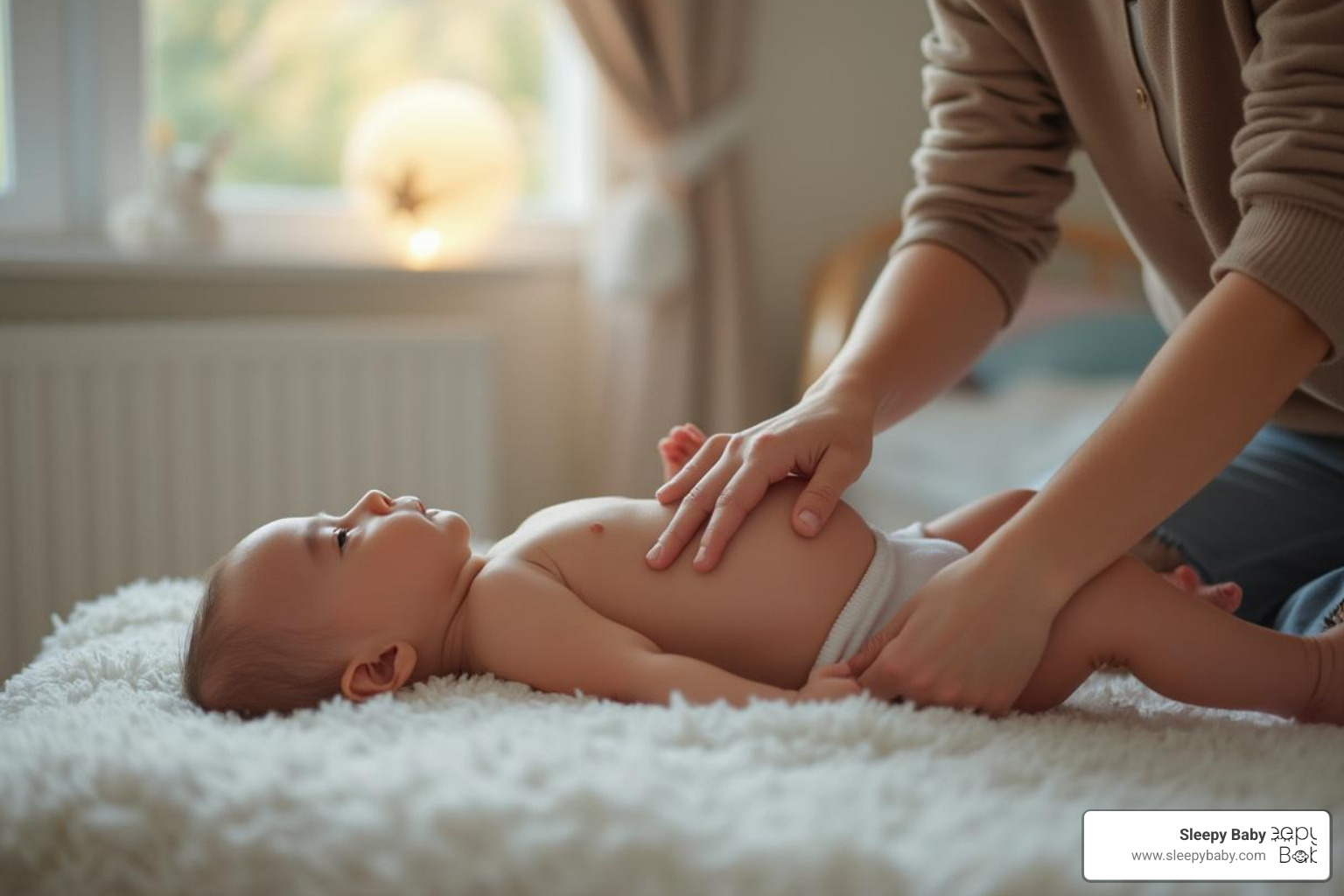
Frequently Asked Questions About Colic Relief Devices
As a parent who's been through the exhausting cycle of colic nights, I know you probably have a dozen questions racing through your mind when considering a colic relief device. Let me address the most common concerns I hear from other parents.
Are colic relief devices safe for newborns?
The short answer is yes - when you choose the right type and use it properly. But let's break this down because safety varies significantly between different devices.
Mechanical gas passers are actually some of the safest options for newborns. They're registered as Class I medical devices with both the Swedish Medical Agency and U.S. FDA, which means they've undergone rigorous safety testing. You can use them from birth until those gas problems typically fade around 3-4 months.
Heated belly bands work well for newborns too, but you'll want to look for specific safety features. The best ones use organic cotton construction and include anti-burn technology. Always test the temperature on your own skin first - if it feels too warm for you, it's definitely too warm for your baby.
Positional cushions can be used from premature birth, but here's where you need to be extra careful. These require your constant supervision and should never be used for sleep. They're wonderful for soothing, but remember - flat surfaces are still the safest for unsupervised rest.
My biggest piece of advice? Talk to your pediatrician before trying any colic relief device, especially if your little one was born early or has any health concerns. They know your baby's specific situation best.
How often can I use a mechanical gas passer in 24 hours?
This is probably the question I get asked most often, and for good reason. The safe limit is no more than three times per day - and this isn't just a random number. Medical professionals who developed these devices established this guideline to prevent irritation to your baby's delicate rectal area.
Here's what proper usage looks like: space each use at least 4-6 hours apart, and stop immediately if you notice any redness or irritation. If you find yourself reaching for it more than three times daily, that's actually valuable information. It might mean you need to explore other types of colic relief devices or discuss underlying feeding issues with your healthcare provider.
I remember feeling frustrated when three times didn't seem like enough during those really tough evenings. But overuse can cause more problems than it solves, and there are other approaches you can layer in between uses.
Do gadgets replace traditional soothing like rocking or swaddling?
Not at all - and honestly, I'm glad you asked this question because it touches on something really important. Colic relief devices are tools that improve your natural parenting abilities, not replacements for your loving touch.
Think of it this way: you might use a heated belly band while you're rocking your baby, or apply a mechanical gas passer and then follow up with gentle swaddling. The device handles the physical discomfort, but your presence provides the emotional comfort that no gadget can replicate.
The most effective approach I've seen combines both worlds. The device addresses the root mechanical problem - like trapped gas or digestive discomfort - while traditional techniques like swaddling, rocking, and singing provide the emotional regulation your baby needs.
Your baby doesn't just need physical relief from colic pain. They need to feel safe, loved, and secure. That's something only you can provide. The ideal scenario uses devices to solve the physical problem quickly, then layers in all that wonderful human comfort for complete soothing.
At Sleepy Baby, this philosophy guides everything we create - our solutions are designed to complement and support your natural parenting instincts, never to replace the irreplaceable comfort of a parent's care.
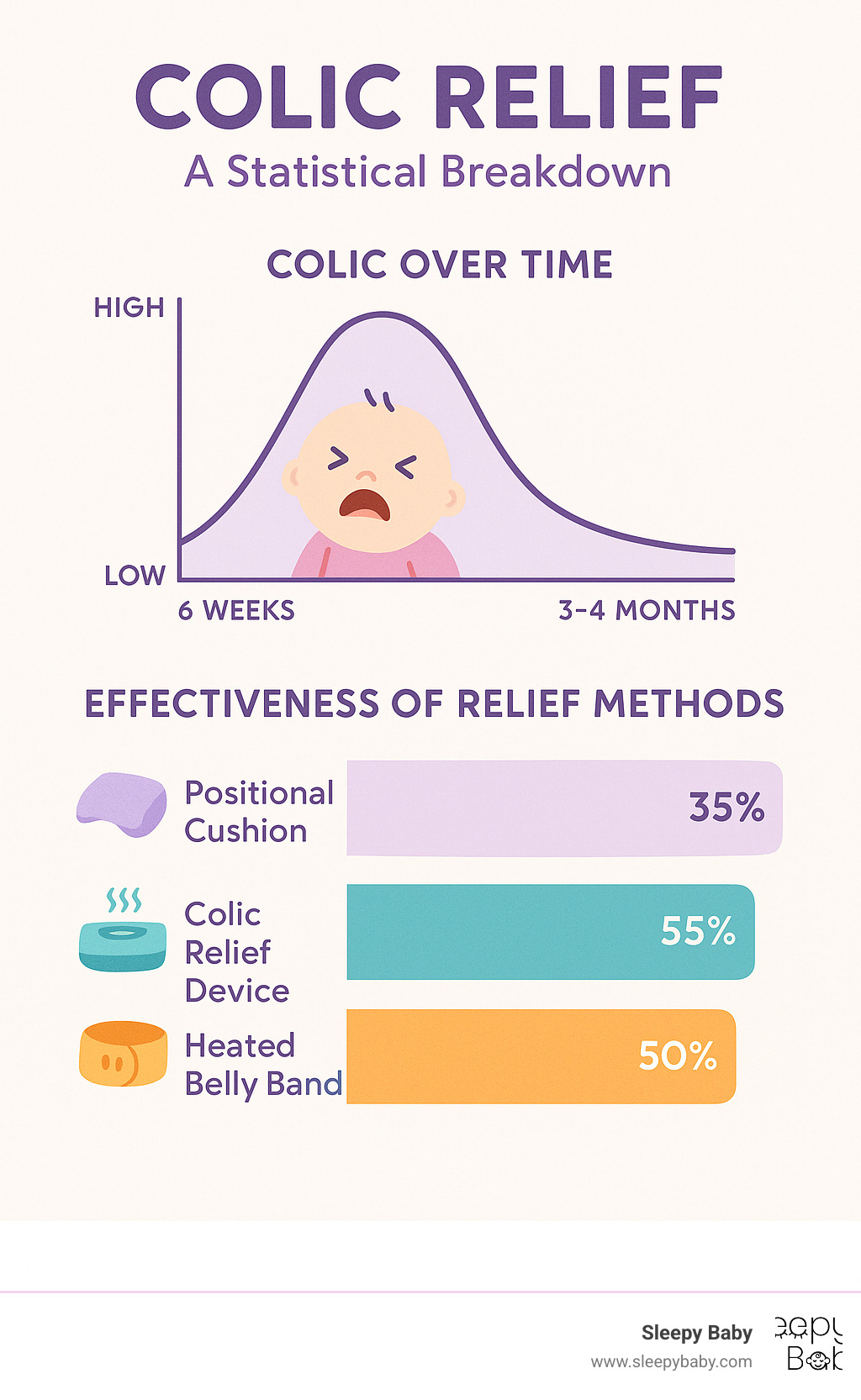
Conclusion
Those sleepless nights with a crying baby don't have to feel endless. Finding the right colic relief device can transform your family's most challenging moments into manageable ones, giving both you and your baby the comfort you desperately need.
The journey through colic is different for every family. Some parents find instant success with mechanical gas passers that provide immediate relief from trapped air. Others find that heated belly bands offer the gentle, ongoing comfort their baby craves. And many find that positional cushions become lifesavers for babies who struggle with reflux.
The real magic happens when you combine these devices with your natural parenting instincts. A colic relief device works best alongside the rocking, singing, and gentle touch that only you can provide. These tools don't replace your loving care - they improve it, giving you more ways to help your baby feel better.
Colic typically peaks around 6 weeks and improves dramatically by 3-4 months. You're not failing as a parent if your baby cries for hours despite your best efforts. Up to 20% of babies experience colic, and having the right tools makes this temporary phase much more bearable.
Safety always comes first, so follow usage guidelines carefully and don't hesitate to consult your pediatrician. Every baby is unique, and what works for one might not work for another. Be patient with yourself and your little one as you figure out what brings the most relief.
At Sleepy Baby, we created our intelligent sleep aids specifically because we understand how exhausting these early months can be. Our devices use rhythmic patting and white noise to provide hands-free comfort that works beautifully alongside the colic relief devices we've discussed. When your baby finally settles from gas pain, having consistent sleep support helps everyone get the rest they need.
More info about Sleepy Baby sleep aid
You're doing an amazing job, even when it doesn't feel like it. With the right combination of tools, techniques, and patience, you'll help your baby through this challenging phase while taking care of yourself too. Better nights are coming, and you have everything you need to get there.


